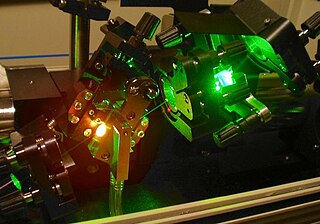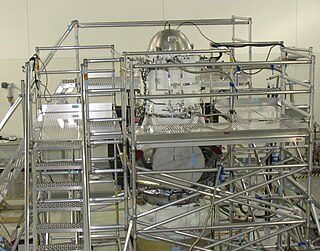Principle
The cutting process is performed by a femtosecond laser, emitting radiation in the near-infrared range. Within this wavelength range, the laser is able to penetrate the tissue up to a certain depth without causing thermal damage. By tight focusing of the laser radiation, intensities over 1 TW/cm2 (1 TW = 1012 watts) arise inside the laser focus. These extreme intensities induce nonlinear effects and optical breakdown occurs. This causes the disruption of the material, limited to the focal point. The process is known as photodisruption.
Due to the ultra short pulse duration of only a few femtoseconds (1 fs = 10−15 seconds) there is only very low energy of a few nanojoules (1 nJ = 10−9 joules) per laser pulse deposits into the tissue. This limits the interaction range to diameters below one micrometer (1 μm = 10−6 meters). Out of this range there is no thermal damage.
Moved by a fast scanner, the laser beam writes a cutting plane into the sample. A positioning unit moves the sample simultaneously, so that the sample can be processed within a short time.

A laser is a device that emits light through a process of optical amplification based on the stimulated emission of electromagnetic radiation. The term "laser" originated as an acronym for "light amplification by stimulated emission of radiation". The first laser was built in 1960 by Theodore H. Maiman at Hughes Research Laboratories, based on theoretical work by Charles Hard Townes and Arthur Leonard Schawlow.

In physics, radiation is the emission or transmission of energy in the form of waves or particles through space or through a material medium. This includes:
Mode-locking is a technique in optics by which a laser can be made to produce pulses of light of extremely short duration, on the order of picoseconds (10−12 s) or femtoseconds (10−15 s). A laser operated in this way is sometimes referred to as a femtosecond laser, for example in modern refractive surgery. The basis of the technique is to induce a fixed-phase relationship between the longitudinal modes of the laser's resonant cavity. Constructive interference between these modes can cause the laser light to be produced as a train of pulses. The laser is then said to be 'phase-locked' or 'mode-locked'.

Ti:sapphire lasers (also known as Ti:Al2O3 lasers, titanium-sapphire lasers, or Ti:sapphs) are tunable lasers which emit red and near-infrared light in the range from 650 to 1100 nanometers. These lasers are mainly used in scientific research because of their tunability and their ability to generate ultrashort pulses. Lasers based on Ti:sapphire were first constructed and invented in June 1982 by Peter Moulton at the MIT Lincoln Laboratory.
In physics and physical chemistry, time-resolved spectroscopy is the study of dynamic processes in materials or chemical compounds by means of spectroscopic techniques. Most often, processes are studied after the illumination of a material occurs, but in principle, the technique can be applied to any process that leads to a change in properties of a material. With the help of pulsed lasers, it is possible to study processes that occur on time scales as short as 10−16 seconds.

Ablation is removal or destruction of material from an object by vaporization, chipping, or other erosive processes. Examples of ablative materials are described below, and include spacecraft material for ascent and atmospheric reentry, ice and snow in glaciology, biological tissues in medicine and passive fire protection materials.

Laser cutting is a technology that uses a laser to slice materials. While typically used for industrial manufacturing applications, it is also starting to be used by schools, small businesses, and hobbyists. Laser cutting works by directing the output of a high-power laser most commonly through optics. The laser optics and CNC are used to direct the material or the laser beam generated. A commercial laser for cutting materials uses a motion control system to follow a CNC or G-code of the pattern to be cut onto the material. The focused laser beam is directed at the material, which then either melts, burns, vaporizes away, or is blown away by a jet of gas, leaving an edge with a high-quality surface finish.

A cryostat is a device used to maintain low cryogenic temperatures of samples or devices mounted within the cryostat. Low temperatures may be maintained within a cryostat by using various refrigeration methods, most commonly using cryogenic fluid bath such as liquid helium. Hence it is usually assembled into a vessel, similar in construction to a vacuum flask or Dewar. Cryostats have numerous applications within science, engineering, and medicine.
In optics, an ultrashort pulse of light is an electromagnetic pulse whose time duration is of the order of a picosecond or less. Such pulses have a broadband optical spectrum, and can be created by mode-locked oscillators. They are commonly referred to as ultrafast events. Amplification of ultrashort pulses almost always requires the technique of chirped pulse amplification, in order to avoid damage to the gain medium of the amplifier.

In physics, terahertz time-domain spectroscopy (THz-TDS) is a spectroscopic technique in which the properties of matter are probed with short pulses of terahertz radiation. The generation and detection scheme is sensitive to the sample's effect on both the amplitude and the phase of the terahertz radiation. By measuring in the time-domain, the technique can provide more information than conventional Fourier-transform spectroscopy, which is only sensitive to the amplitude.
A microtome is a tool used to cut extremely thin slices of material, known as sections. Important in science, microtomes are used in microscopy, allowing for the preparation of samples for observation under transmitted light or electron radiation.
Polaritonics is an intermediate regime between photonics and sub-microwave electronics. In this regime, signals are carried by an admixture of electromagnetic and lattice vibrational waves known as phonon-polaritons, rather than currents or photons. Since phonon-polaritons propagate with frequencies in the range of hundreds of gigahertz to several terahertz, polaritonics bridges the gap between electronics and photonics. A compelling motivation for polaritonics is the demand for high speed signal processing and linear and nonlinear terahertz spectroscopy. Polaritonics has distinct advantages over electronics, photonics, and traditional terahertz spectroscopy in that it offers the potential for a fully integrated platform that supports terahertz wave generation, guidance, manipulation, and readout in a single patterned material.

Laser-induced breakdown spectroscopy (LIBS) is a type of atomic emission spectroscopy which uses a highly energetic laser pulse as the excitation source. The laser is focused to form a plasma, which atomizes and excites samples. The formation of the plasma only begins when the focused laser achieves a certain threshold for optical breakdown, which generally depends on the environment and the target material. In principle, LIBS can analyze any matter regardless of its physical state, be it solid, liquid or gas. Because all elements emit light of characteristic frequencies when excited to sufficiently high temperatures, LIBS can detect all elements, limited only by the power of the laser as well as the sensitivity and wavelength range of the spectrograph & detector. If the constituents of a material to be analyzed are known, LIBS may be used to evaluate the relative abundance of each constituent element, or to monitor the presence of impurities. In practice, detection limits are a function of a) the plasma excitation temperature, b) the light collection window, and c) the line strength of the viewed transition. LIBS makes use of optical emission spectrometry and is to this extent very similar to arc/spark emission spectroscopy.

Laser ablation or photoablation is the process of removing material from a solid surface by irradiating it with a laser beam. At low laser flux, the material is heated by the absorbed laser energy and evaporates or sublimates. At high laser flux, the material is typically converted to a plasma. Usually, laser ablation refers to removing material with a pulsed laser, but it is possible to ablate material with a continuous wave laser beam if the laser intensity is high enough. Excimer lasers of deep ultra-violet light are mainly used in photoablation; the wavelength of laser used in photoablation is approximately 200 nm.

Chirped pulse amplification (CPA) is a technique for amplifying an ultrashort laser pulse up to the petawatt level, with the laser pulse being stretched out temporally and spectrally, then amplified, and then compressed again. The stretching and compression uses devices that ensure that the different color components of the pulse travel different distances.
Ultrafast laser spectroscopy is a spectroscopic technique that uses ultrashort pulse lasers for the study of dynamics on extremely short time scales. Different methods are used to examine the dynamics of charge carriers, atoms, and molecules. Many different procedures have been developed spanning different time scales and photon energy ranges; some common methods are listed below.

A photoionization mode is a mode of interaction between a laser beam and matter involving photoionization.

Self-focusing is a non-linear optical process induced by the change in refractive index of materials exposed to intense electromagnetic radiation. A medium whose refractive index increases with the electric field intensity acts as a focusing lens for an electromagnetic wave characterized by an initial transverse intensity gradient, as in a laser beam. The peak intensity of the self-focused region keeps increasing as the wave travels through the medium, until defocusing effects or medium damage interrupt this process. Self-focusing of light was discovered by Gurgen Askaryan.

The Extreme Light Infrastructure (ELI) is a Research Infrastructure (RI) of pan-European interest and part of the European ESFRI Roadmap. ELI hosts the most intense beamline system worldwide, develop new interdisciplinary research opportunities with light from these lasers and secondary radiation derived from them, and make them available to the international scientific user community. ELI aims to be the world's biggest and first international user facility in beamline and laser research.
Pulsed operation of lasers refers to any laser not classified as continuous wave, so that the optical power appears in pulses of some duration at some repetition rate. This encompasses a wide range of technologies addressing a number of different motivations. Some lasers are pulsed simply because they cannot be run in continuous mode.













